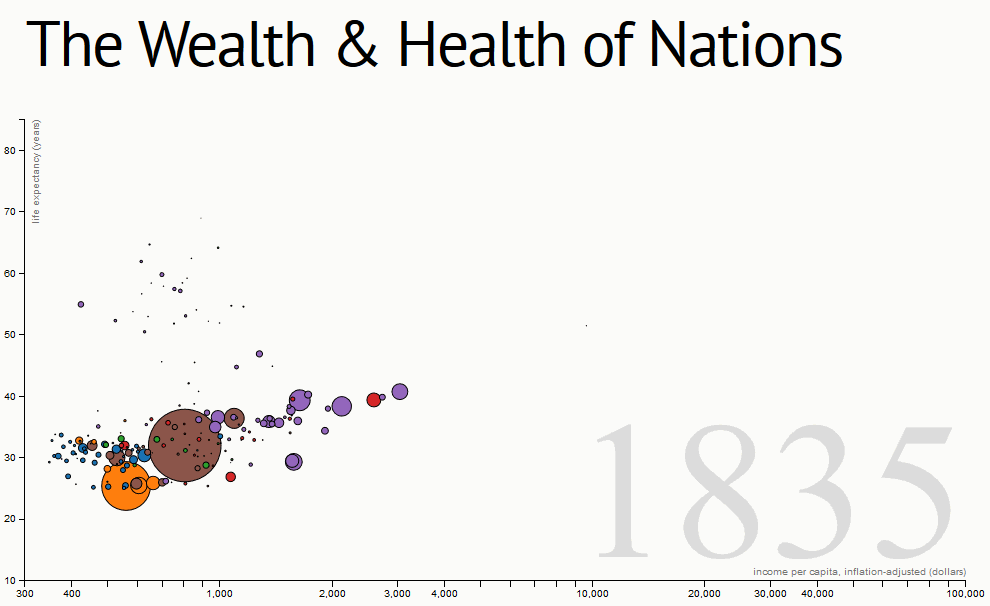Estoy tratando de replicar la lista de Naciones de Salud y Riqueza.
http://bost.ocks.org/mike/nations/:

Cuando hago clic en Iniciar la animación del gráfico, que funciona perfectamente y si hago clic en detener las paradas de animación. Sin embargo, si hago clic en el inicio la próxima vez, ¿está comenzando desde el principio desde donde me detuve? ¿Cómo animo desde el lugar donde me fui?
El siguiente es el código:
<h1>The Wealth & Health of Nations</h1>
<p id="chart"></p>
<input type="submit" value="Start" onclick=start();>
<input type="submit" value="Stop" onclick=stop();>
<script src="http://d3js.org/d3.v2.js?2.8.1"></script>
<script>
// Various accessors that specify the four dimensions of data to visualize.
function x(d) { return d.income; }
function y(d) { return d.lifeExpectancy; }
function radius(d) { return d.population; }
function color(d) { return d.region; }
function key(d) { return d.name; }
// Chart dimensions.
var margin = {top: 29.5, right: 29.5, bottom: 29.5, left: 59.5},
width = 960 - margin.right,
height = 500 - margin.top - margin.bottom;
// Various scales. These domains make assumptions of data, naturally.
var xScale = d3.scale.log().domain([300, 1e5]).range([0, width]),
yScale = d3.scale.linear().domain([10, 85]).range([height, 0]),
radiusScale = d3.scale.sqrt().domain([0, 5e8]).range([0, 40]),
colorScale = d3.scale.category10();
// The x & y axes.
var xAxis = d3.svg.axis().orient("bottom").scale(xScale).ticks(12, d3.format(",d")),
yAxis = d3.svg.axis().scale(yScale).orient("left");
// Create the SVG container and set the origin.
var svg = d3.select("#chart").append("svg")
.attr("width", width + margin.left + margin.right)
.attr("height", height + margin.top + margin.bottom)
.append("g")
.attr("transform", "translate(" + margin.left + "," + margin.top + ")");
// Add the x-axis.
svg.append("g")
.attr("class", "x axis")
.attr("transform", "translate(0," + height + ")")
.call(xAxis);
// Add the y-axis.
svg.append("g")
.attr("class", "y axis")
.call(yAxis);
// Add an x-axis label.
svg.append("text")
.attr("class", "x label")
.attr("text-anchor", "end")
.attr("x", width)
.attr("y", height - 6)
.text("income per capita, inflation-adjusted (dollars)");
// Add a y-axis label.
svg.append("text")
.attr("class", "y label")
.attr("text-anchor", "end")
.attr("y", 6)
.attr("dy", ".75em")
.attr("transform", "rotate(-90)")
.text("life expectancy (years)");
// Add the year label; the value is set on transition.
var label = svg.append("text")
.attr("class", "year label")
.attr("text-anchor", "end")
.attr("y", height - 24)
.attr("x", width)
.text(2000);
function start()
{
//alert("Start Clicked");
// Load the data.
d3.json("nations_new.json", function(nations) {
// A bisector since many nation's data is sparsely-defined.
var bisect = d3.bisector(function(d) { return d[0]; });
// Add a dot per nation. Initialize the data at 2000, and set the colors.
var dot = svg.append("g")
.attr("class", "dots")
.selectAll(".dot")
.data(interpolateData(2000))
.enter().append("circle")
.attr("class", "dot")
.style("fill", function(d) { return colorScale(color(d)); })
.call(position)
.sort(order);
// Add a title.
dot.append("title")
.text(function(d) { return d.name; });
// Add an overlay for the year label.
var box = label.node().getBBox();
var overlay = svg.append("rect")
.attr("class", "overlay")
.attr("x", box.x)
.attr("y", box.y)
.attr("width", box.width)
.attr("height", box.height);
//.on("mouseover", enableInteraction);
// Start a transition that interpolates the data based on year.
svg.transition()
.duration(30000)
.ease("linear")
.tween("year", tweenYear)
.each("end", enableInteraction);
// Positions the dots based on data.
function position(dot) {
dot .attr("cx", function(d) { return xScale(x(d)); })
.attr("cy", function(d) { return yScale(y(d)); })
.attr("r", function(d) { return radiusScale(radius(d)); });
}
// Defines a sort order so that the smallest dots are drawn on top.
function order(a, b) {
return radius(b) - radius(a);
}
// After the transition finishes, you can mouseover to change the year.
function enableInteraction() {
var yearScale = d3.scale.linear()
.domain([2000, 2009])
.range([box.x + 10, box.x + box.width - 10])
.clamp(true);
// Cancel the current transition, if any.
svg.transition().duration(0);
overlay
.on("mouseover", mouseover)
.on("mouseout", mouseout)
.on("mousemove", mousemove)
.on("touchmove", mousemove);
function mouseover() {
label.classed("active", true);
}
function mouseout() {
label.classed("active", false);
}
function mousemove() {
displayYear(yearScale.invert(d3.mouse(this)[0]));
}
}
// Tweens the entire chart by first tweening the year, and then the data.
// For the interpolated data, the dots and label are redrawn.
function tweenYear() {
var year = d3.interpolateNumber(2000, 2009);
return function(t) { displayYear(year(t)); };
}
// Updates the display to show the specified year.
function displayYear(year) {
dot.data(interpolateData(year), key).call(position).sort(order);
label.text(Math.round(year));
}
// Interpolates the dataset for the given (fractional) year.
function interpolateData(year) {
return nations.map(function(d) {
return {
name: d.name,
region: d.region,
income: interpolateValues(d.income, year),
population: interpolateValues(d.population, year),
lifeExpectancy: interpolateValues(d.lifeExpectancy, year)
};
});
}
// Finds (and possibly interpolates) the value for the specified year.
function interpolateValues(values, year) {
var i = bisect.left(values, year, 0, values.length - 1),
a = values[i];
if (i > 0) {
var b = values[i - 1],
t = (year - a[0]) / (b[0] - a[0]);
return a[1] * (1 - t) + b[1] * t;
}
return a[1];
}
});
}
function stop()
{
//alert("stop Clicked");
svg.transition().duration(0);
}
El archivo JSON es:
[
{
"name":"Angola",
"region":"Sub-Saharan Africa",
"income":[[2000,2446.65],[2001,2479.69],[2002,2773.29],[2003,2785.39],[2004,3007.11],[2005,3533],[2006,4069.56],[2007,4755.46],[2008,5228.74],[2009,5055.59]],
"population":[[2000,10442812],[2001,10623424],[2002,10866106],[2003,11186202],[2004,11521432],[2005,11827315],[2006,12127071],[2007,12420476],[2008,12707546]],
"lifeExpectancy":[[2000,43.56],[2001,43.86],[2002,44.22],[2003,44.61],[2004,45.05],[2005,45.52],[2006,46.02],[2007,46.54],[2008,47.06],[2009,47.58]]
},
{
"name":"china",
"region":"East Asia & Pacific",
"income":[[2000,12446.65],[2001,12479.69],[2002,12773.29],[2003,12785.39],[2004,12007.11],[2005,12533],[2006,12069.56],[2007,12755.46],[2008,12228.74],[2009,12055.59]],
"population":[[2000,31542812],[2001,31623424],[2002,31866106],[2003,32186202],[2004,31521432],[2005,31827315],[2006,32127071],[2007,32420476],[2008,32707546]],
"lifeExpectancy":[[2000,53.56],[2001,63.86],[2002,64.22],[2003,64.61],[2004,76.05],[2005,66.52],[2006,86.02],[2007,87.54],[2008,89.06],[2009,68.58]]
},
{
"name":"India",
"region":"South Asia",
"income":[[2000,22446.65],[2001,22479.69],[2002,22773.29],[2003,22785.39],[2004,22007.11],[2005,22533],[2006,22069.56],[2007,22755.46],[2008,22228.74],[2009,22055.59]],
"population":[[2000,41542812],[2001,41623424],[2002,41866106],[2003,42186202],[2004,41521432],[2005,41827315],[2006,42127071],[2007,42420476],[2008,42707546],[2009,42707546]],
"lifeExpectancy":[[2000,43.56],[2001,43.86],[2002,44.22],[2003,64.61],[2004,56.05],[2005,56.52],[2006,66.02],[2007,68.54],[2008,67.06],[2009,73.58]]
}
]
